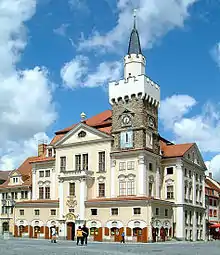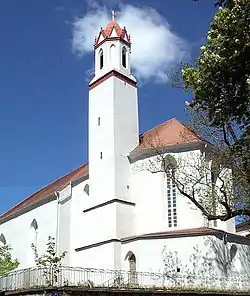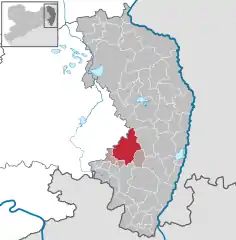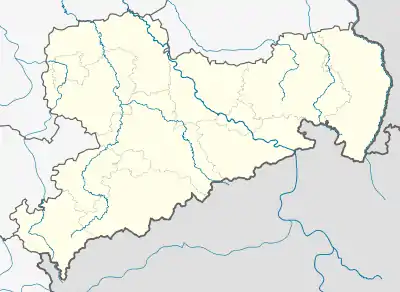Löbau
Löbau (Upper Sorbian: Lubij) is a city in the east of Saxony, Germany, in the traditional region of Upper Lusatia. It is situated between the slopes of the Löbauer Berg and the fertile hilly area of the Upper Lusatian Mountains. It is the gateway to this volcanic mountainous area and is situated halfway between the cities of Bautzen, Görlitz and Zittau.

Löbau | |
|---|---|
 | |
 Coat of arms | |
Location of Löbau within Görlitz district  | |
 Löbau  Löbau | |
| Coordinates: 51°05′40″N 14°40′0″E | |
| Country | Germany |
| State | Saxony |
| District | Görlitz |
| Municipal assoc. | Löbau |
| Government | |
| • Mayor (2021–28) | Albrecht Gubsch[1] |
| Area | |
| • Total | 78.74 km2 (30.40 sq mi) |
| Elevation | 260 m (850 ft) |
| Population (2021-12-31)[2] | |
| • Total | 14,277 |
| • Density | 180/km2 (470/sq mi) |
| Time zone | UTC+01:00 (CET) |
| • Summer (DST) | UTC+02:00 (CEST) |
| Postal codes | 02708 |
| Dialling codes | 03585 |
| Vehicle registration | GR, LÖB, NOL, NY, WSW, ZI |
| Website | loebau.de |
History
Löbau was first mentioned in 1221 as "Oppidum Lubaw". During the Middle Ages the city was a member of the Lusatian League, consisting of the six cities Bautzen, Görlitz, Kamenz, Lauban, Löbau and Zittau. The regional alliance was first established in 1346 and disbanded in 1815. The league was revived in 1991, though it no longer holds political power and mostly acts as a tourism promotion board.
The town is widely known for the piano manufacturing company August Förster.
Main sights
The town hall of the city is a noteworthy mixture of several architectural styles. Another famous building is the Schminke House by German architect Hans Scharoun, one of the most important exponents of organic and expressionist architecture. The building dates from the 1930s, anticipating the architecture of the 1950s. It is regarded as one of Scharoun's greatest works.[3]
The King Frederick Augustus Tower is Löbau's main landmark; the tower made of cast iron was built in 1854 on the Löbauer Berg, and is 28 m tall. It is the biggest cast-iron tower in Europe and offers magnificent views of the Lusatian Highlands.[4]
Politics
Reichstag Deputies
Following the North German Confederation Treaty the Kingdom of Saxony entered the North German Confederation in 1866.[5] This continued after the founding of the German Empire on 18 January 1871.[6] Following this Saxony participated in Reichstag elections from February 1867. Löbau returned a series of Reichstag Deputies until 1919 when the existing constituencies were scrapped.
International relations
People
- August Förster (1829-1897), piano maker
- Marie Wackwitz (1865-1930), women's rights activist
- Georg Scholze (1897-1945), general during World War II
- Konrad Kujau (1938-2000), forger
- Bernd Böhlich (*1957), director
- Uwe Proske (*1961), Olympic gold medalist (1992, fencing)
- Anne-Kathrin Schade (*1968), volleyball player
- Jana Henke (*1973), swimmer
- Mirko Müller (*1974), pair skater
- René Münnich (*1977), auto racing driver and team owner
- Robert Koch (*1986), footballer (formerly Dynamo Dresden, 1. FC Nürnberg)
- Christian Reitz (*1987), Olympic gold medalist (2016, 25 metre rapid fire pistol) and world record holder
References
- Bürgermeisterwahlen 2021, Freistaat Sachsen (in German). Retrieved 16 November 2021.
- "Bevölkerung des Freistaates Sachsen nach Gemeinden am 31. Dezember 2021" (XLS) (in German). Statistisches Landesamt des Freistaates Sachsen. 2022.
- "Willkommen im Haus der Moderne". loebau.de (in German). Retrieved 2019-09-22.
- "Wahrzeichen König-Friedrich-August-Turm". loebau.de (in German). Retrieved 2019-09-22.
- Headlam, J. W. "Bismarck and the Foundation of the German Empire by J. W. Headlam". www.heritage-history.com. Heritage History. Retrieved 19 August 2020.
- J. W., Headlam. "Bismarck and the Foundation of the German Empire by J. W. Headlam". www.heritage-history.com. Heritage History. Retrieved 19 August 2020.
- "Löbaus Partnerstädte". loebau.de (in German). Archived from the original on 2019-05-27. Retrieved 2019-09-22.
External links
- Official website of the city of Löbau (German)
- Homepage of the Schminke House
- Homepage of the modern Lusatian League (German)
